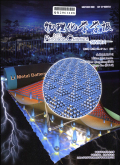物理化学学报2024,Vol.40Issue(4):4-10,7.DOI:10.3866/PKU.WHXB202306046
一例整合了三联吡啶钌和卟啉锌的金属-有机框架材料用于光催化二氧化碳还原全反应
Integration of Ru(Ⅱ)-Bipyridyl and Zinc(Ⅱ)-Porphyrin Moieties in a Metal-Organic Framework for Efficient Overall CO2 Photoreduction
摘要
Abstract
Efficiently converting CO2 and H2O into value-added chemicals using solar energy is a viable approach to address global warming and the energy crisis.However,achieving artificial photocatalytic CO2 reduction using H2O as the reductant poses challenges is due to the difficulty in efficient cooperation among multiple functional moieties.Metal-organic frameworks(MOFs)are promising candidates for overall CO2 photoreduction due to their large surface area,diverse active sites,and excellent tailorability.In this study,we designed a metal-organic framework photocatalyst,named PCN-224(Zn)-Bpy(Ru),by integrating photoactive Zn(Ⅱ)-porphyrin and Ru(Ⅱ)-bipyridyl moieties.In comparison,two isostructural MOFs just with either Zn(Ⅱ)-porphyrin or Ru(Ⅱ)-bipyridyl moiety,namely PCN-224-Bpy(Ru)and PCN-224(Zn)-Bpy were also synthesized.As a result,PCN-224(Zn)-Bpy(Ru)exhibited the highest photocatalytic conversion rate of CO2 to CO,with a production rate of 7.6 µmol·g-1·h-1 in a mixed solvent of CH3CN and H2O,without the need for co-catalysts,photosensitizers,or sacrificial agents.Mass spectrometer analysis detected the signals of 13CO(m/z = 29),13C18O(m/z = 31),16O18O(m/z = 34),and 18O2(m/z = 36),confirming that CO2 and H2O acted as the carbon and oxygen sources for CO and O2,respectively,thereby confirming the coupling of photocatalytic CO2 reduction with H2O oxidation.In contrast,using PCN-224-Bpy(Ru)or PCN-224(Zn)-Bpy as catalysts under the same conditions resulted in significantly lower CO production rates of only 1.5 and 0 µmol·g-1·h-1,respectively.Mechanistic studies revealed that the lowest unoccupied molecular orbital(LUMO)potential of PCN-224(Zn)-Bpy(Ru)is more negative than the redox potentials of CO2/CO,and the highest occupied molecular orbital(HOMO)potential is more positive than that of H2O/O2,satisfying the thermodynamic requirements for overall photocatalytic CO2 reduction.In comparison,the HOMO potential of PCN-224(Zn)-Bpy without Ru(Ⅱ)-bipyridyl moieties is less positive than that of H2O/O2,indicating that the Ru(Ⅱ)-bipyridyl moiety is thermodynamically necessary for CO2 reduction coupled with H2O oxidation.Additionally,photoluminescence spectroscopy revealed that the fluorescence of PCN-224(Zn)-Bpy(Ru)was almost completely quenched,and a longer average photoluminescence lifetime compared to PCN-224(Zn)-Bpy and PCN-224-Bpy(Ru)was observed.These suggest a low recombination rate of photogenerated carriers in PCN-224(Zn)-Bpy(Ru),which also supported by the higher photocurrent observed in PCN-224(Zn)-Bpy(Ru)compared to PCN-224(Zn)-Bpy and PCN-224-Bpy(Ru).In summary,the integrated Zn(Ⅱ)-porphyrin and Ru(Ⅱ)-bipyridyl moieties in PCN-224(Zn)-Bpy(Ru)play important roles of a photosensitizer and CO2 reduction as well as H2O oxidation sites,and their efficient cooperation optimizes the band structure,thereby facilitating the coupling of CO2 reduction with H2O oxidation and resulting in high-performance artificial photocatalytic CO2 reduction.关键词
金属有机框架/锌(Ⅱ)卟啉衍生物/联吡啶(Ⅱ)钌配合物/光生电荷/光催化CO2还原Key words
Metal-organic framework/Zn(Ⅱ)porphyrin/Ru(Ⅱ)bipyridyl complex/Photogenerated charge/CO2 photoreduction分类
化学引用本文复制引用
陈慧滢,朱浩林,廖培钦,陈小明..一例整合了三联吡啶钌和卟啉锌的金属-有机框架材料用于光催化二氧化碳还原全反应[J].物理化学学报,2024,40(4):4-10,7.基金项目
The project was supported by the National Key Research and Development Program of China(2021YFA1500401),the National Natural Science Foundation of China(21890380 and 21821003),the Local Innovative and Research Teams Project of the Guangdong Pearl River Talents Program,China(2017BT01C161),and the Technology Innovation Strategy Special City and County Science and Technology Innovation Support Project,China(STKJ2023078).国家重点研发计划(2021YFA1500401),国家自然科学基金(21890380,21821003),广东省"珠江人才计划"本土创新科研团队项目(2017BT01C161)和广东省科技创新战略专项市县科技创新支撑项目(STKJ2023078)资助 (2021YFA1500401)

